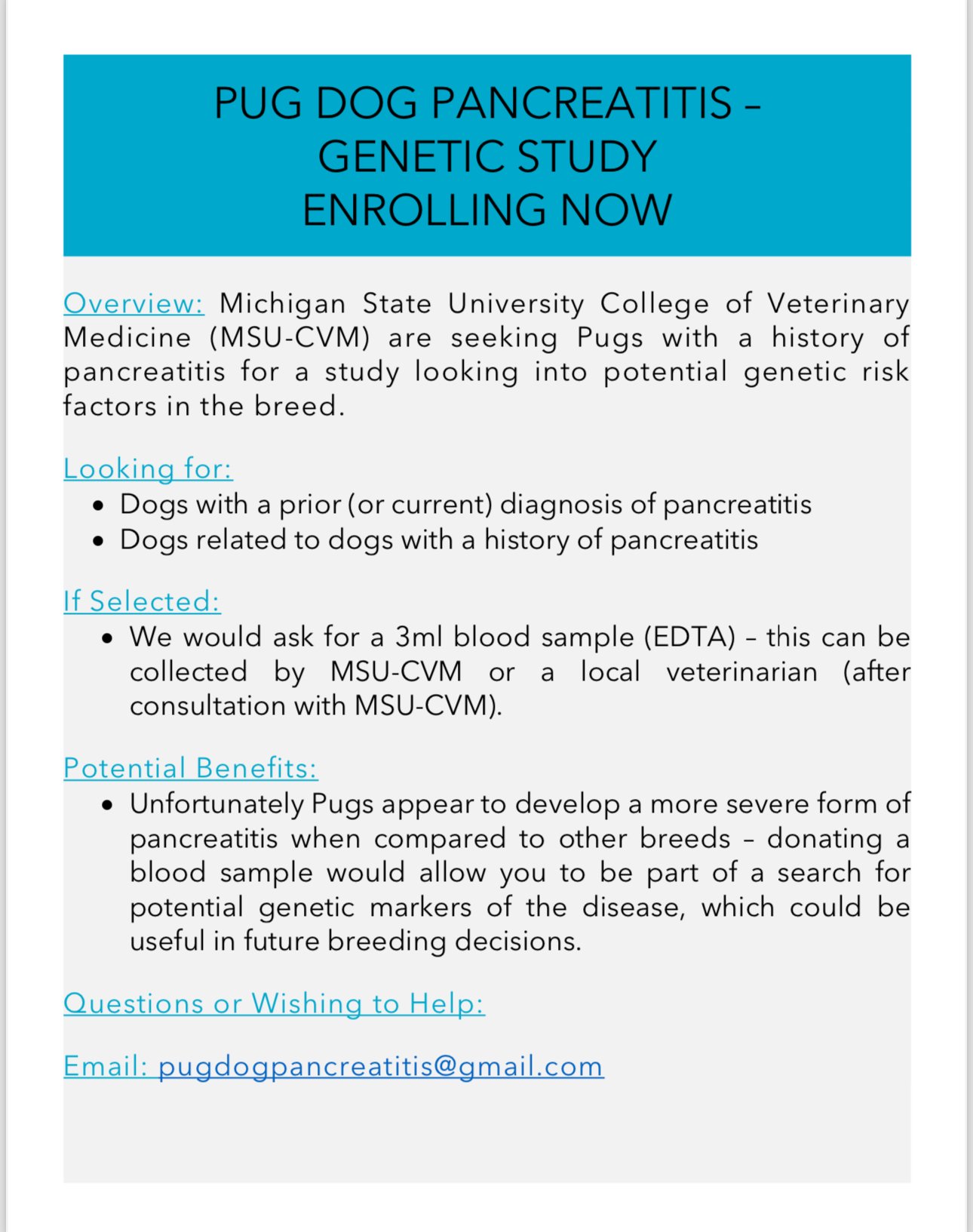
The Pug Dog Club of America supports the CHIC registry (Canine Health Information Center).
PDCA Required tests for CHIC Number:
PDE (Pug Dog Encephalitis)
Eye Exam – CERF or ACVO Find an ACVO Ophthalmologist
Patella evaluation
*Note – In addition to the breed specific requirements above, a CHIC requirement across all participating breeds is that the dog must be permanently identified via microchip or tattoo in order to qualify for a CHIC number.
PDCA optional tests for CHIC:
Hip Dysplasia - OFA Evaluation
Elbow Dysplasia (Optional) - OFA Evaluation
Pyruvate Kinase Deficiency (PKD) (Optional) - DNA based from an approved lab
Serum Bile Acid Test for puppies
OFA Spine Evaluation - OFA radiographic evaluation for SpineTracheal Hypoplasia - OFA radiographic evaluation for Tracheal Hypoplasia.
Cardiac Evaluation - Advanced Cardiac Exam or Basic Cardiac Exam
Photo Credit: Blanca Clothier
Read below for more information regarding PDE, Pug Myelopathy, Hip Dysplasia, Luxating Patellas, and BOAS.
Pug Dog Encephalitis (PDE)
PDE is a fatal inflammatory brain disease. We do not know exactly why Pugs get it. We are beginning to explore ways to treat it. There is no way to determine with accuracy if your Pug has it except with the brain tissue of dead dogs. The Pugs who are affected are usually young. The dogs will have seizures, circling, blindness, coma and death, all in the space of a few days to a few weeks. The Pug Dog Club of America, along with the American Kennel Club Canine Health Foundation, has contributed to studies which has directly led to the creation of a test for the genetic marker for PDE – or NME, Necrotizing Meningoencephalitis, as it is scientifically called. This is the first step towards identifying, understanding, treating and possibly eradicating this horrible disease from our Pug population.
We now know that not only is the Pug breed at risk, but also the Maltese, Chihuahua, Shih Tzu, Lhasa Apso, Boston Terrier, Papillion, Pekingese, Pomeranian, Yorkshire Terrier and West Highland White Terrier breeds.
2024 Pug Dog Club of America Health seminar presented by Dr. Windsor. Click here to view the seminar on youtube.
Pug Myelopathy
Pug Myelopathy is considered the most frequent cause of rear limb incoordination (ataxia) and progress to paralysis of the rear limbs over a period of one to four years. The rear legs appear to be weak, but the cause is a neurological deficit that develops in the spine. Affected dogs may initially drag their feet, stagger, have trouble jumping and can be fecal and urinary incontinent. It usually affects just the rear limbs, unlike a very different disease, Degenerative Myelopathy (DM), which can have similar initial signs, but progresses tragically to complete paralysis and death. In Pug Myelopathy, we are learning there is usually a complex of spinal abnormalities that involve both the vertebral bones, and can also involve compression of the spinal cord. The compression can be caused by one (or multiple lesions) that include one or multiple sites of chronic Hansen type II intervertebral disc disease (IVDD); spinal arachnoid diverticulum (SAD); spinal cord atrophy; and fibrosis of the arachnoid layer of the meninges. Unraveling the relationships between these conditions is one goal of the research at Michigan State University funded by the Pug Dog Club of America.
Other names that refer to Pug myelopathy include “Pug constrictive myelopathy (CM)”, “facet hypoplasia”, “subarachnoid diverticulum (SAD)” and others. Although little is published about this condition, Pug Myelopathy may be the most common cause of mid-back spinal cord problems in Pugs.
Many veterinarians are not yet knowledgeable about this condition, as published information is not yet widely available. Pugs with rear limb ataxia may have had a previous diagnosis that was incomplete in light of this evolving information. Since so little is known, there is no consensus among neurologists about the best way to treat it. Surgery may be appropriate for individual cases, but it must be considered as soon as possible, after symptoms first occur, and may only delay progression of paralysis.
The most important palliative treatment appears to be consistent physical therapy using rehabilitation exercises to preserve muscle strength and enhance development of a spinal walk. Pugs affected with Pug Myelopathy are usually pain free and can lead excellent long lives with good nursing care. All senior Pugs require periodic wellness exams to detect and alleviate other problems of aging using medication and/or supplements. It is critical the Pug is carefully monitored for its ability to completely empty the urinary bladder several times a day. Several other well documented conditions in Pugs also cause symptoms of ataxia, including hemivertebrae (usually young dogs); acute sudden onset Intervertebral Disc Disease (IVDD) or “slipped disc” – (usually painful); spinal cord tumors; and spinal arthritis in elder dogs. It is important to have your primary care veterinarian arrange a referral for your Pug for an examination by a board certified veterinary neurologist or surgeon when symptoms of ataxia first appear.
For More Information about Pug Myelopathy contact
Kathleen L. Smiler, DVM, DACLAM
PO Box 429
Lakeville, MI 48366
248-953-3182 FAX 248-751-5900
smilerk@mindspring.com
pugrearataxiaparalysis.com/






